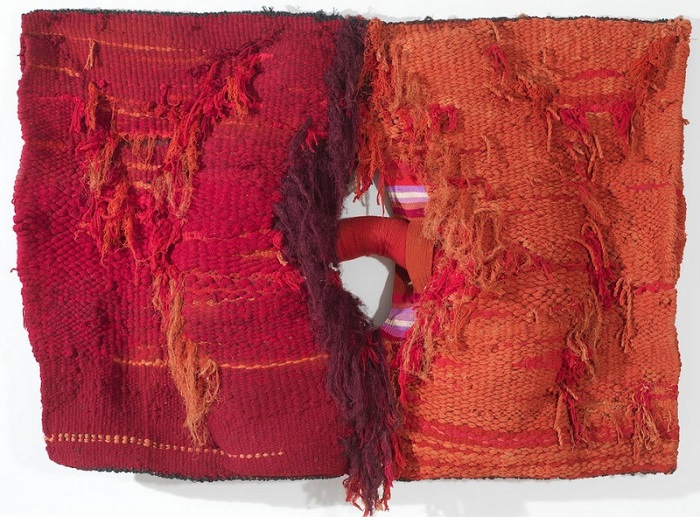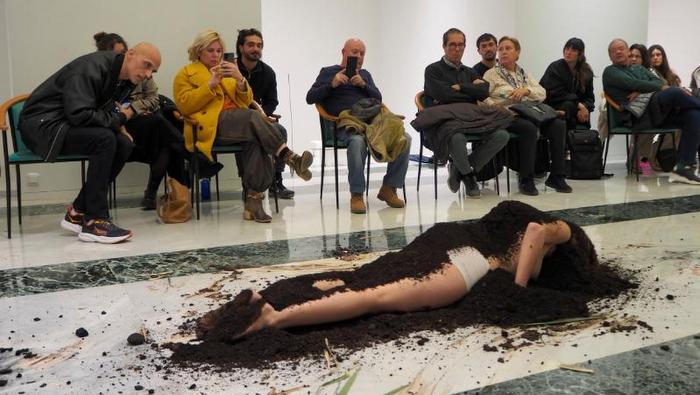Michel Soskine Inc. is pleased to present during “Apertura Madrid Week End” the second exhibition of one of XXth century most important contemporary textile artist Josep Grau-Garriga (1929-2011): 12 tapestries from 1972 to the years 2000 will show the evolution of an oeuvre that transit from early political and stormy works made in Cataluña to later more playful and sculptural creations while he was living in Saint Mathurin, in the French region of Angers, - known for its "douceur de vivre".
Following the recent presentation of one of Grau Garriga´s monumental tapestry in Basel Art Unlimited Section by American curator Gianni Jetzer (Hirschhorn Museum Art of Washington), the selection of works in the present exhibition will deepen the knowledge of Josep Grau-Garriga´s role and the creativity he developed through the use of non-conventional materials. By investigating the path of an “ Informalist “ vision since the late 50´s, his work took a new direction which, at the time, embodied a true revolution in contemporary tapestry.
Primarily handled by European monarchies during the Gothic and Renaissance period as a symbol of power, tapestry has seen in recent years a renaissance through the works of contemporary artists as well as a renewed interest on the part of museums and institutions such as the recent Sheila Hicks' exhibition at the Pompidou Center or several museum group exhibitions about Textile Art.
Josep Grau-Garriga was born in 1929 in Sant Cugat del Vallès in the heart of a family of farmers. The country land left a deep impression on him together with an environment where Catalan Romanesque mural painting can be seen and admired in churches and castles..
In 1957 Josep Grau Garriga traveled to France and met Jean Lurçat, who, at the time, was considered the master of textile art. At his side, he acquired knowledge of different techniques which he would later apply to his workshop in Sant Cugat.. During that time in France, Grau Garriga became acquainted with the work of several informal artists he met such as Fautrier, Dubuffet and Burri. This influence will lead Grau-Garriga to overcome the traditional pictorial concept and to further the importance of materials in his oeuvre:
'I realized that I could think and execute a tapestry using any kind of 'string' that was within my reach at any given time and that it seemed to me that its presence in textile weaving was necessary and effective'.
From 1959 to 1969, Grau Garriga, just in his 30´s, began to gradually move from figuration to total abstraction and decided to give up the traditional technique of 'Alto Lizo' to begin manipulating the threads like a sculptor. His tapestries became increasingly more complex, using jute, rope, wool, sisal, hemp, metal, and in the later years incorporated as collage various elements of clothing such as shirts, trousers or sweaters like in the work 'Cada Día' (1992) .
After his first 1964 solo exhibition at Sala Joan Gaspar, his work attracted the interest of Joan Miró, Antoni Tàpies and Pablo Picasso who began to visit his studio in Sant Cugat.
In 1969 his meeting with young curator Phillipe de Montebello, future Director of the Metropolitan Museum of Art in New York, led the following year to the first major retrospective of Grau-Garriga work at The Museum of Fine Arts, Houston in Texas. This relationship lead him to collaborate to several projects at the LACMA in Los Angeles in 1974 and at the Rufino Tamayo Museum in Mexico in 1987.
In 2013 the Musée d'Art Moderne de la Ville de Paris in its collective exhibition 'Decorum' dedicated to textile art , paid homage to Grau-Garriga as well as other major textile artists such as Maryn Varbanov, Jagoda Buić or Annette Messager.
Collections
MACBA - Museu d'Art Contemporani de Barcelona, Barcelona (España).
Fundació Vila Casas, Barcelona (España).
Museo de Arte Contemporáneo, Elche (España).
Museo de Arte Contemporáneo, Sevilla (España).
Museu Tèxtil, Tarrasa (España).
Museo Provincial de Teruel (España).
Museu de Villafamès, Castelló (España).
Museo de Bellas Artes Gravina, Alicante (España).
The Metropolitan Museum of Art, Nueva York (EEUU).
The Brooklyn Museum, New York (EEUU).
The Denver Art Museum, Denver (EEUU).
The Houston Fine Arts Museum, Houston (EEUU).
The Cordoba Museum, Lincoln (EEUU).
The Oklahoma Art Centre, Oklahoma (EEUU).
Fondation Toms Pauli, Lausana (Suiza).
Musée Jean-Lurçat, Angers (Francia).
Musée des Beaux Arts, Angers (Francia).
Musée Goya-Jaurés, Angers (Francia).
Musée Réattu, Angers (Francia).
Musée Cantini, Marseille (Francia).
Musée du château des ducs de Wurtemberg, Montbéliard (Francia).
Musée de la Ville, Montpellier (Francia).
Musée d'Art moderne de la Ville de Paris, Paris (Francia)
Musée Hyacinthe Rigaud, Perpignan (Francia).
Musée des Beaux Arts, Saint Ló (Francia).
Frac Ile-de-France, Paris (Francia).
FRAC Lorraine, Metz (Francia).
Museo Salvador Allende, Santiago de Chile (Chile).
Museo Rufino Tamayo, México DF (México).
Exhibitions selection
2018 ‘Josep Grau-Garriga’ Michel Soskine Inc, Madrid (España).
2017 'Josep Grau Garriga: Tapestries 1970 - 2011' Salon 94 Bowery, Nueva York (EEUU).
2016 'Tapisseries: 1970 - 2011' Galerie Nathalie Obadia, Paris (Francia).
2015 ‘Josep Grau Garriga. Formas Tejidas.’, Michel Soskine Inc., Madrid. (España).
2010 Musée des Beaux-Arts d'Angers, Cabinet d'arts graphiques, Angers (Francia).
2009 Abbaye de Saint-Florent-le-Vieil (Francia).
2002 Abbaye de Ronceray y Musée Jean Lurçat d'Angers, Angers (Francia).
1999 Canals Galeria d'Art, Sant Cugat (España). Galería Benassar. Madrid (España). Galería Blanquerna. Madrid (España). Galerie Xavier Delannoy, La Garde-Freinet (France).
1996 Canals Galeria d'Art, Sant Cugat (España).
1993 Templo romano de Vic, Vic (España).
1992 Centre Cultural Can Mulà, Mollet del Vallès (España). Galería Punto, Valencia (España). Institut Français de Côte d'Ivoire, Abidjan (Costa de Marfil).
1990 Museu d'Història de Sabadell, Sabadell (España). Canals Galeria d'Art, Sant Cugat (España).
1989 Musée Jean Lurçat, Angers (Francia).
1988 Palau Robert, Barcelona (España).
1987 Museo Rufino Tamayo, México DF (México).
1985 Claustros del Monasterio Real, Sant Cugat del Vallès (España). Musée du Château des ducs de Wurtemberg, Montbéliard (Francia).
1983 Arras Gallery, Nueva York (EEUU). 1982 Claustros del Monasterio Real, Sant Cugat del Vallès (España). Cité de Carcassone, Carcassone (Francia).
1981 Palais de la UNESCO, París (Francia).
1975 The Birmingham Museum of Fine Arts, Birmingham (EEUU).
1974 Arras Gallery, Nueva York (EEUU). Los Ángeles County Museum, Los Ángeles. (EEUU).
1973 Arras Gallery, Nueva York (EEUU). Galeria René Metrás, Barcelona (España). Museu Tèxtil, Terrassa (España).
1972 Sala del Consell de les Valls, Andorre la Vielle (Andorra). Galería Antoñana, Caracas (Venezuela).
1971 Arras Gallery, Nueva York (EEUU). The Birmingham Museum of Fine Arts, Birmingham (EEUU).
1970 The Houston Fine Arts Museum, Houston (EEUU). The Córdoba Museum, Lincoln, Massachusetts (EEUU).
1968 Galerie La Demeure, Paris (Francia). Sala F. Domingo, Sao Paulo (Brasil).
1967 Sala de Exposiciones, Dirección General de Bellas Artes, Madrid (España).
1964 Sala Gaspar, Barcelona (España).















